Sweet Dumpling Is The Lesser-Known Winter Squash You'll Want To Try
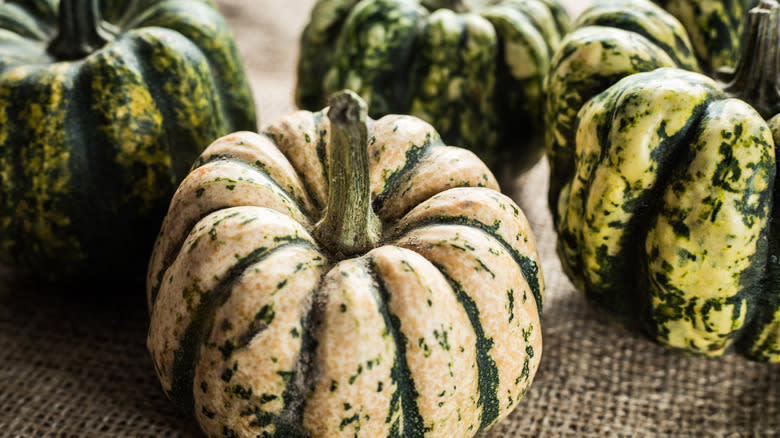
At first glance, winter squashes may all appear relatively the same. However, with dozens of varieties, these hardy vegetables have more to offer than you may expect and are good for much more than merely serving as a seasonal decoration.
Winter squashes indeed share some common traits, such as their ability to store for weeks or even months after being harvested in the fall. Their ability to keep well into the winter, even though they're grown through the summer, is why we call them winter squash. But their versatility in the kitchen, from soups to pies, makes the many varieties genuinely worth getting to know better.
You're likely already familiar with pumpkin, butternut, and acorn squash, as they're some of the most popular and easy-to-find types of winter squash. Yet, each kind of squash offers unique taste, texture, size, and shape characteristics. The sweet dumpling is one such winter squash. It may not be the most popular type of squash, and perhaps you've never even heard of it before, but it's definitely one worth exploring. Here's everything you need to know to enjoy the sweet dumpling squash.
Read more: 23 Types Of Potatoes And When To Use Them
What Is Sweet Dumpling Squash?
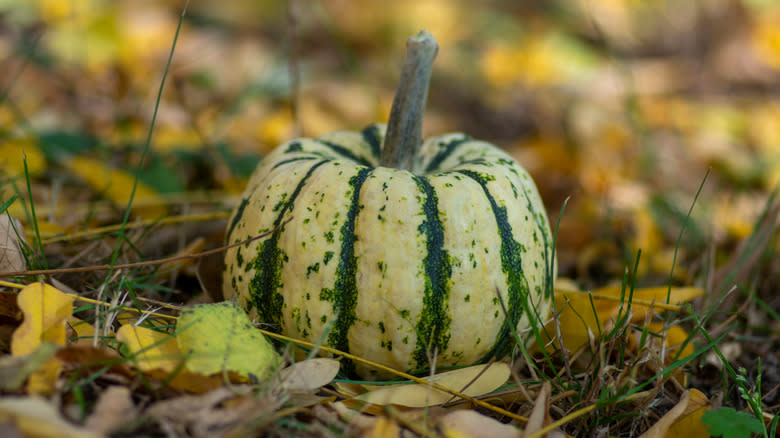
Although it is one of the lesser-known winter squashes, when you catch a glimpse of a sweet dumpling squash, it will quickly catch your eye. With its cream-colored skin speckled and striped in green and orange, this squash is intriguing and easily recognizable.
One of the nice things about this squash is its size. Unlike butternut or the unwieldy blue hubbard squash, the sweet dumpling typically weighs less than a pound and is the ideal size for an individual serving. At four to five inches in diameter, it's easy to slice open, scoop out the seeds, and cook with little additional prep needed. And who doesn't love a food that is naturally its own self-contained vessel?
Similar in shape to an acorn squash, the sweet dumpling has vertical scalloped ridges running down from the stem. No one will blame you if you mistake it for the carnival squash, which is also scalloped and has a similar pattern on its skin. However, the sweet dumpling is more squat, whereas the carnival is larger and elongated. Interestingly, the carnival squash is a hybrid of sweet dumplings and acorn squashes, so it's no surprise that they share many of the same traits.
What Does Sweet Dumpling Squash Taste Like?
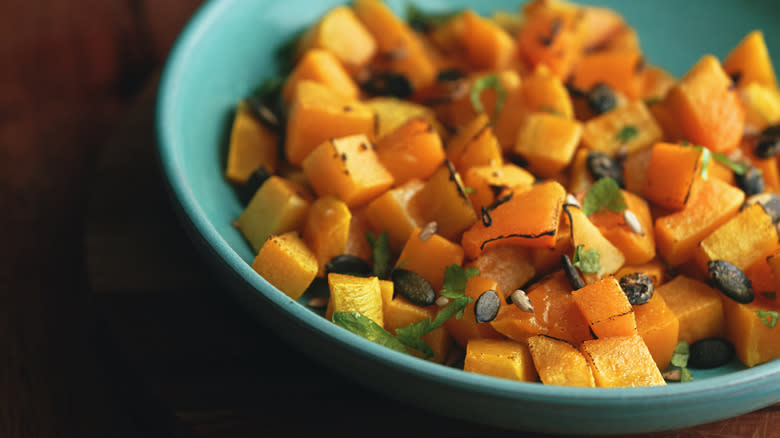
Sweet dumpling squash has the ideal combination of sweet and nutty flavors, which makes it an excellent choice for fall and winter cooking. Its orange flesh becomes creamy when cooked, and its taste and texture work well for both sweet and savory dishes.
Another noteworthy feature of the sweet dumpling squash is that it has an edible skin. The skin not only adds a bit of earthy flavor, but it also contributes additional fiber and other nutrients. Not to mention, edible skin makes prepping the squash even easier, as there is no need to struggle with a peeler on the uneven edges of the squash. Of course, you'll want to wash the squash well before cooking and eating the skin.
The other taste worth mentioning is that of the sweet dumpling's seeds. While pumpkin seeds are most commonly roasted and enjoyed as a snack, the seeds of all winter squash, including sweet dumplings, may be roasted and eaten. Because sweet dumpling squash seeds are smaller, they will taste crispier than some of the other larger squash seeds after roasting. They may then be seasoned and enjoyed as a snack or used as a savory garnish for soups and salads.
How To Cook Sweet Dumpling Squash
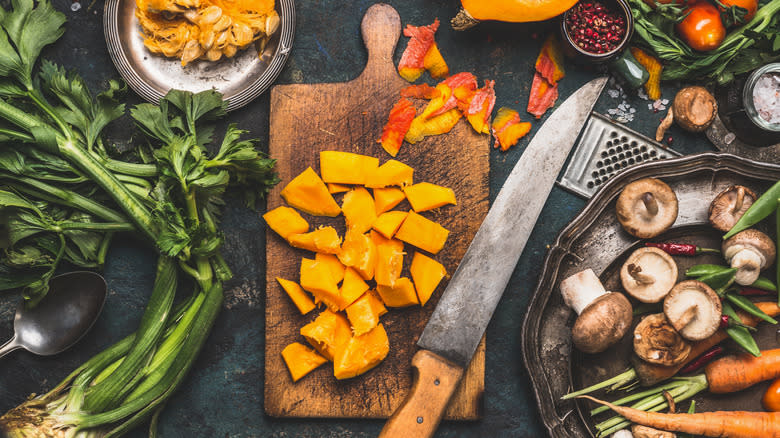
There are many ways to cook and enjoy sweet dumpling squash. The most common of which is roasting. The small size and edible skin make it simple to slice the squash in half, pop it on a tray into a 400 F oven, and cook until tender. But don't make the big mistake people make when cooking winter squash and assume roasting is the only way to go about cooking it. There are several other options.
If you're short on time, this squash will cook up faster in the microwave than in the oven. All you need to do is halve or cut the squash into large chunks, place it on a plate, and cook it in the microwave for ten or so minutes or until tender when pierced with a fork. Another alternative is to cut up the squash and steam it in a pan on top of the stove.
Whichever of these methods you may choose, you may want to season the squash with butter, fresh herbs, and spices of your choosing. Though once cooked, the flesh of the squash is suitable for pureeing and turning into a soup or even use in place of pumpkin in a pie. Because of the edible skin and smaller size, you'll want to keep in mind yet another benefit of the sweet dumpling squash: It'll cook quicker than some of the larger and more dense winter squashes.
What To Pair With Sweet Dumpling Squash
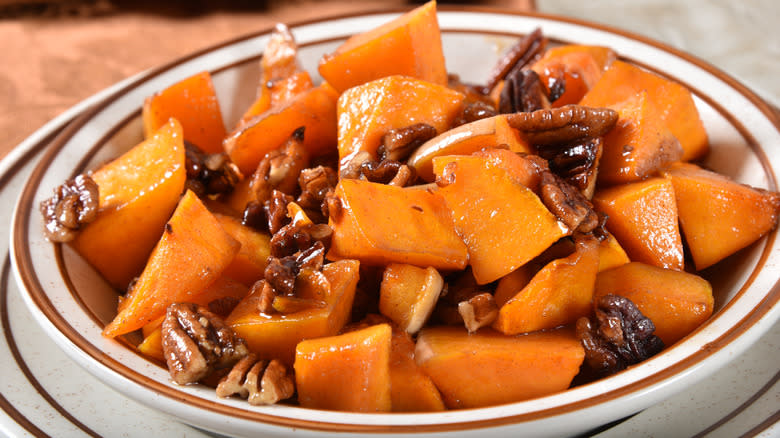
When thinking about what to pair with sweet dumpling squash, you can consider the same ingredients you would use with other winter squash you may have cooked before. A good place to start is with complimentary flavors that build upon the sweet and nutty flavor profiles.
You might consider maple syrup, brown sugar, or honey for sweet components to add to the squash. Or if you don't want to add such pure sweetness, apples, with their natural sweetness, would go well when cooked together. On the other hand, to enhance the nuttiness of the squash, add toasted walnuts or pecans to your final dish. Not only will the flavors pair nicely, but the soft, tender squash and crunchy nuts will provide a pleasant balance of textures.
Consider trying a different approach with contrasting ingredients. Earthy-flavored herbs like rosemary, sage, and thyme can help balance out the inherent sweetness of the squash. Spices can also work well, and not just the sweeter ones like cinnamon and nutmeg. Consider a deeper flavor from something like smoked paprika or perhaps a curry powder. Ultimately, the ingredients you choose to combine with sweet dumpling squash will depend on your cooking method and the final dish you want to prepare. The way you flavor and pair ingredients will be significantly different for a pie than it would be for serving the squash as a side dish.
Where To Buy Sweet Dumpling Squash

As eye-catching, easy to cook, and versatile as the sweet dumpling squash may be, it is not always as easy to locate in stores as other winter squash. You will have the best luck finding it in grocery stores with more extensive and diverse produce departments. Or if you have a food co-op near you, you may want to check there, as they tend to carry local produce and items that are harder to find than chain grocery stores.
You may have the best luck locating sweet dumpling squash at your local farmers market. Farmers markets tend to offer more uncommon produce items, and besides, everyone knows vegetables taste better from a farmers market than a grocery store. Even better, the farmer might share a story about growing the squash, its origins, or perhaps a favorite way they like to cook it.
No matter where you're looking for sweet dumpling squash, don't forget that these are harvested in the fall, so you will not see them in the spring or the middle of summer. As with most winter squash varieties, fall and early winter are the times to track them down. And when all else fails, it never hurts to ask the produce manager at your grocery store if they could find some for you or chat with a local farmer to see if they'd consider growing some in the future. It never hurts to ask.
How To Select A Sweet Dumpling Squash
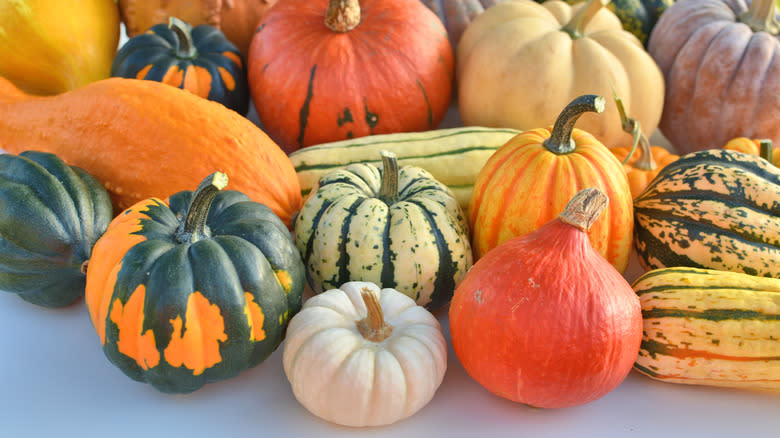
It's not difficult to identify a quality sweet dumpling squash. Since you can't cut a squash open before purchasing it, you have to rely on what you can observe of the exterior and what you can feel from holding it.
Start with the most apparent observations and look for any cuts or general indentations on the surface of the squash. You want to pick one that does not have these features because if the flesh is exposed, it's likely to rot soon or already be rotting inside. Look for one with a dry stem and skin with vibrant yet matte colors, as these all indicate that the squash is ripe and ready for cooking.
Notice what you feel when you hold the sweet dumpling squash in your hands. If the squash feels heavy for its size, this is good, as it tells you the squash flesh contains moisture and is not old and dried out. Dry squash will end up tough and leathery when cooked. You will also want to ensure the squash feels firm when pressing it. Any soft spots will tell you that the squash is rotting. Finally, when you press your fingernail into the squash, you shouldn't be able to pierce the skin. Winter squash, even sweet dumpling with thinner skin, should not be easily pierced.
How To Store Sweet Dumpling Squash
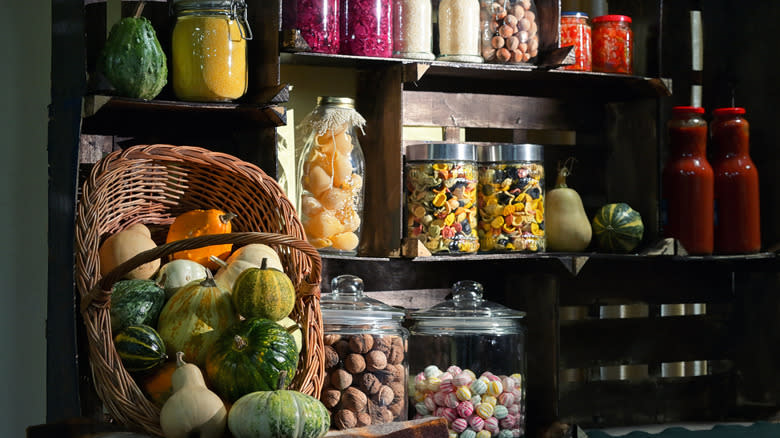
If you tend to throw all of your produce in the fridge, no matter what it is, there's no need to do that with sweet dumpling squash. Save your limited fridge space for the produce that needs it most. Instead, this squash is best stored in a cooler, darker place such as a pantry, cabinet, or even the cellar. Wherever you choose, just make sure it is out of direct sunlight. Remember, its ability to store well is one of the wonderful aspects of winter squash.
That said, since sweet dumpling squash has a thinner skin, they won't keep quite as well as some of the thicker-skinned alternatives. Some types of squash keep fresh the longest, and this isn't one of them.
You'll want to aim to use your sweet dumpling within a few weeks, and with any produce, you'll want to check it every so often to keep an eye out for any signs of decay. If you notice it getting soft, you'll want to put it in the fridge and use it immediately. And if you happen to have cut the squash but don't use it all the way, that's another instance where you'll want to store it in the refrigerator.
What To Use In Place Of Sweet Dumpling Squash
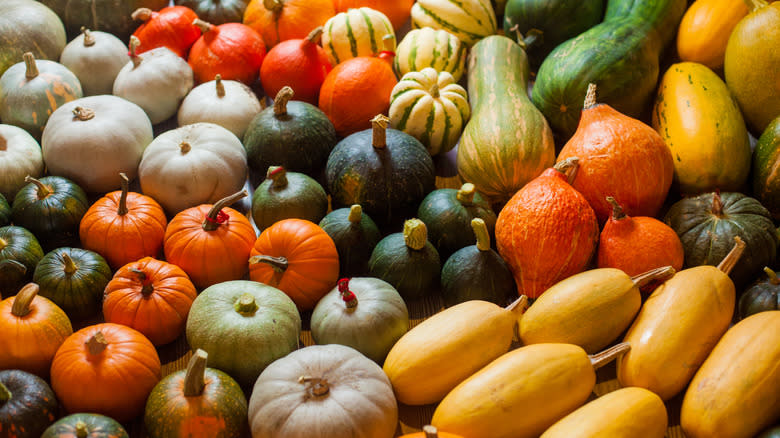
The sweet dumpling squash clearly has some unique qualities that make it stand out from the crowd. However, if you can't find it, similar winter squash alternatives are available depending on which of its qualities you're after.
For instance, the carnival squash is one of the best alternatives, as it has a similar size, shape, and appearance, and as a partial hybrid of the sweet dumpling, it will be the closest comparison. However, if you care about having a winter squash with edible skin, your best options are the carnival or delicata. There's no need to peel either of them.
Butternut or sugar pumpkin, in comparison, are also worthy substitutes if you prefer a creamy squash with sweet and nutty flavors. Though for a squash with an equally small size that is good for individual servings, the honeynut makes a good choice. At the end of the day, you can't go wrong with many of the other winter squashes. The spaghetti squash is the only one that will not make a suitable substitution, as its texture and flavor are significantly different.
Nutritional Information About Sweet Dumpling Squash
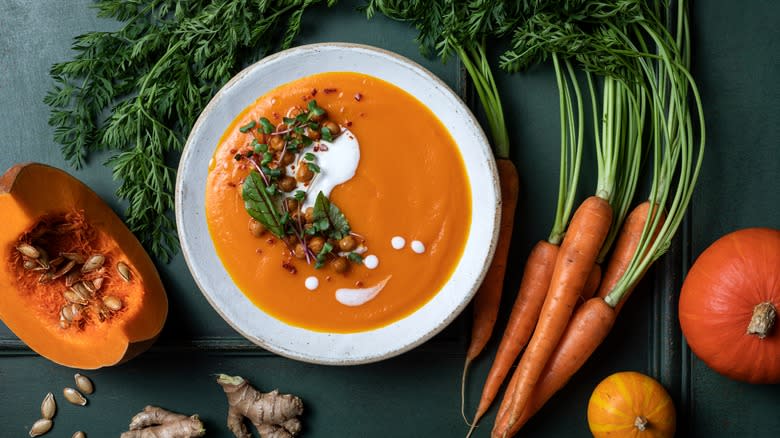
Winter squashes like the sweet dumpling are well-rounded, nutritionally packed vegetables. They're low in calories yet high in fiber, which means they will help to keep you feeling full for longer without having to consume a large amount of food. What more could you ask for?
Along with being a great source of dietary fiber, winter squashes are also loaded with a nutrient known as beta-carotene. This nutrient is classified as a pro-vitamin, which means that it helps your body produce vitamin A. Vitamin A is essential for a number of processes in the body, including helping to support a healthy immune system, boosting your vision, and keeping your skin looking healthy. Winter squashes actually owe their bright orange hue to the existence of beta-carotene in their flesh. So not only does winter squash add color to your plate, but it's packing a ton of nutritional value in the process.
Sweet Dumpling Squash Recipe Ideas
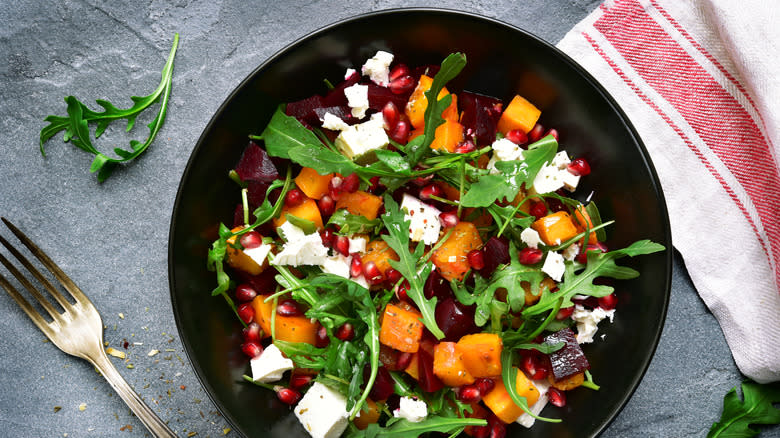
What's great about winter squashes is that while they all have their nuances, many recipes you'll find are interchangeable from one squash to another. There's no need to get hung up on finding recipes specific to this variety. Here are some of our recipes that, although not written for sweet dumpling squash, would be easy to adapt.
One place to start is with stuffed squash recipes. Sweet dumplings are ideal for stuffing with their personal size, hollow inside, and edible skin. You could make either this stuffed acorn squash recipe with sausage and kale or this vegetarian kasha-stuffed acorn squash with pomegranates, pine nuts, and mint. The only thing you'd have to change with the recipes is to reduce the cooking time on the squash since sweet dumpling are smaller than acorn.
Of course, any roasted winter squash recipe could be used for the sweet dumpling, and this maple and spice-roasted winter squash is perfect for those who love a sweet side dish chock full of warming spices. The same rule applies to recipes for squash soup, such as this easy roasted butternut squash recipe with brown butter. Use an equal amount of sweet dumpling squash and peel off the skin after roasting rather than peeling beforehand.
Read the original article on Tasting Table.

